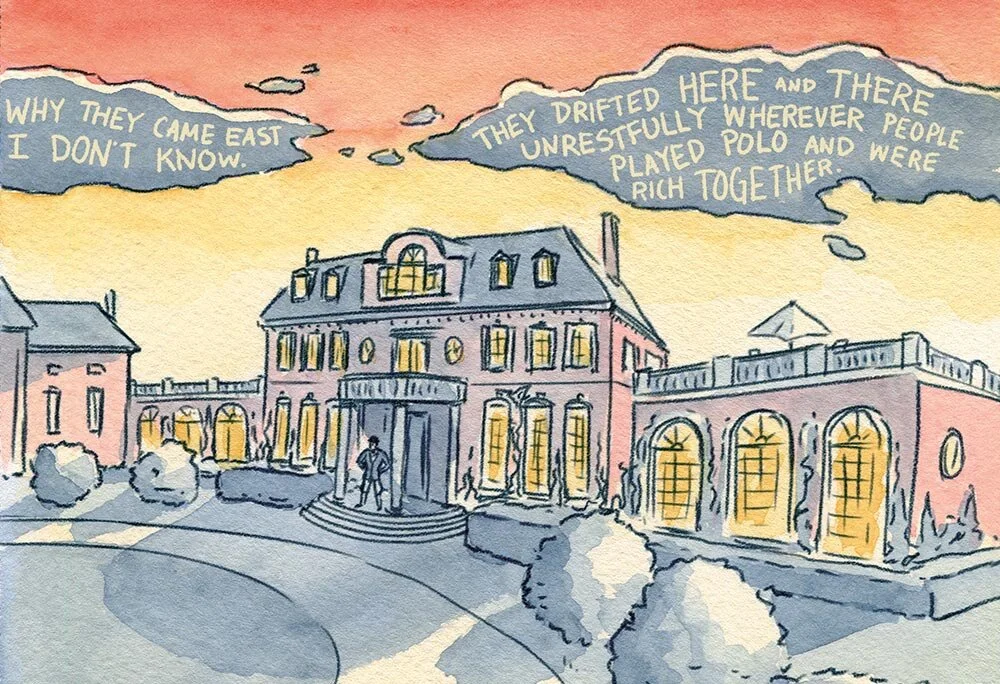When adapting The Great Gatsby into a graphic novel, I tried to prioritize the mood of the story and what worked in the graphic novel medium above perfect veracity to the text.
When debating as to whether or not to include a scene or line, I’d ask myself if it drove the story forward, if it offered the reader new information about the character and story, or if it related to the main theme I was trying to highlight which was class. I really love The Great Gatsby and so it hurt to cut lines that I love. Of course, I encourage everyone to read the original version if you haven’t already so you can see the beauty of Fitzgerald’s language yourself.
How to incorporate Fitzgerald’s text into The Great Gatsby: A Graphic Novel Adaptation
An example of narration hand-lettered into the environment of The Great Gatsby: A Graphic Novel Adaptation
Even though Fitzgerald’s language is beyond beautiful, I wanted to be careful about how much text I included in my graphic novel adaptation. The Great Gatsby is a somewhat airy and fast-paced story and I worried that too much text would weigh it down and not capture the mood of the story. How I dealt with the amount of text I wanted to include was by incorporating much of Nick’s narration as hand lettering which blends into the environment—for example, floating in the clouds, or written in a shadow. This was quite a challenge to do since I dislike hand-lettering, but it felt like the right choice for the story since it allowed me to include more text, but kept the text from weighing down the story or taking away from the art.
Anti-Semitism
For good and bad, The Great Gatsby is very much a book of its time. It includes some racist depictions in it, that as a modern-day author made me extremely uncomfortable to depict, especially with the Jewish gangster Meyer Wolfshiem. This is what I wrote in the Afterward of my book about this challenge:
Nick’s depiction of Meyer Wolfshiem is especially difficult. Although both Wolfshiem and Gatsby engage in illegal activity and are essentially gangsters, Gatsby is described as a mythic and beautiful character while the depiction of Wolfshiem is an anti-Semitic caricature of a Jewish mobster. I wasn’t comfortable depicting Wolfshiem in this way, but I kept him intimidating and mysterious by showing him as backlit and in shadow.
I also changed Meyer Wolfshiem’s words in Fitzgerald’s work from “gonnection” to “connection” and “Oggsford” to “Oxford.” I vacillated about this change. On one hand, I wanted to be true to the text, and these well-known lines are often used by English teachers to discuss anti-Semitism. On the other hand, I had removed the visual caricature of Wolfshiem as well as the other accents in the book. In the end, my editor and I decided not to use text that is offensive and does not drive the story forward. Furthermore, accents indicated places during Fitzgerald’s time; however, accents are no longer anchored to locations.
Historical Accuracy in The Great Gatsby: A Graphic Novel Adaptation
How historically accurate I should be was an area that caused me great anxiety while I worked. I love historical movies and television, but unlike those multi-million dollar productions, I didn’t have a costume design team, or a consultant on staff to check for historical accuracy of the costumes, cars, or set. It was only me, and I was working under a very tight deadline so I couldn’t afford to take the time to make sure everything in my book was accurate to the time period.
1920s Fashion and Cars
I visited the Larz Anderson Auto Museum in Brookline, Massachusetts, to get a better sense of the cars that would appear in The Great Gatsby.
I tried to be somewhat historically accurate, but I didn’t constrict myself to only including fashion, cars, and furniture from 1922 (when the book is set) or earlier. I borrowed from the 1920s, 1930s, and even my own imagination. I used reference books such as 1920s Fashion: The Definitive Sourcebook and websites such as Vintage Dancer which were extremely helpful. I visited the Larz Anderson Auto Museum to get a better sense of the cars from the time period (those cars were huge!)
I’m sure that historians and devoted fans of the 1920s will pick up on many inaccuracies such as the amount of knee length skirts and fringe and feather headdresses I used in the party scenes. Although these did exist in the 1920s, they were much less common than the popular perception of the times. On the men’s fashion side, the men’s vests are visible, even when their jacket is fully buttoned closed. If I were being historically accurate, their vests would be hidden when their jacket was closed. I tried drawing it that way, but then the men looked like they were wearing lab coats which wasn’t particularly appealing! As with all my decisions in the book, I tried to balance between being true to the text and capturing the mood of the book.
Order The Great Gatsby: A Graphic Novel Adaptation at your local independent bookstore or online:


